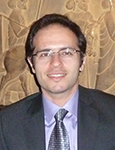Research
Contact
Communications Specialist
Faculty of Engineering
Spencer Engineering Building
Room 2072
Western University
Tel: 519-661-2111 ext. 87015
Email: engineeringcomms@uwo.ca
The Engineer's Impact - Abouzar Sadrekarimi
Your inside look at faculty’s research and its effect on society
In this new Q&A series, we’ll feature Western Engineering faculty members to gain a succinct overview of their research, understand its impact on society, and discover intriguing little-known facts.
Meet Civil and Environmental Engineering Associate Professor Abouzar Sadrekarimi.
 Can you describe your research?
Can you describe your research?
I study the mechanical behaviour and strength of geomaterials, including soil, mine waste, tire derived aggregates, organic soils, and peat and innovative techniques to improve their strength so they can withstand structural loads.
How does your research impact society in everyday life?
My research helps to design safer structures and stabilize slopes and foundations. A particularly impactful area of my research is the safety of mine tailings dams. Tailings dams contain mine waste tailings following the extraction of valuable minerals and resources such as gold, copper, and bitumen. Because of their very large size, loose deposition and high-water content, tailings dams are highly susceptible to failure and instability, as shown by the recent tailings dam failures in Brazil. My research aims to understand the strength of mine tailings and methods to improve their strength so more stable tailings dams can be built.
What’s an interesting, little-known fact related to your research?
One of the innovative aspects of my current research is the use of urease-producing microbes to cement soil and mine tailings. We cultivate and grow these bacteria in soil and under proper conditions, these bacteria can precipitate calcium chloride (calcite) and cement soil particles. We have seen significant improvements in soil and tailings shear strength with this technique. We are currently working on upscaling this technique to actual structures, resolving some practical challenges, and studying methods to reduce the cost of this innovative technique. Note that the bacteria we use are non-pathogenic, often exist in the ground and have little toxicity to humans or the environment.

